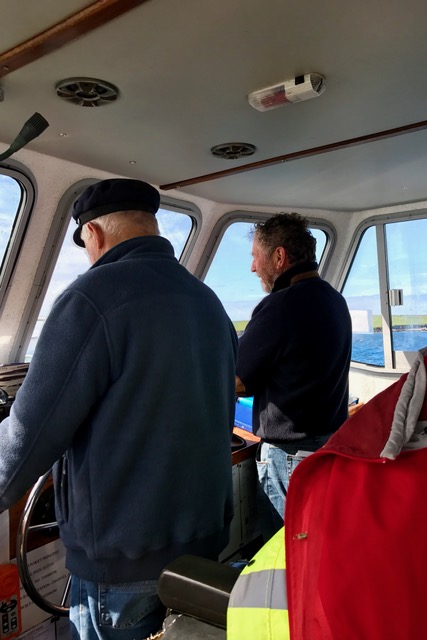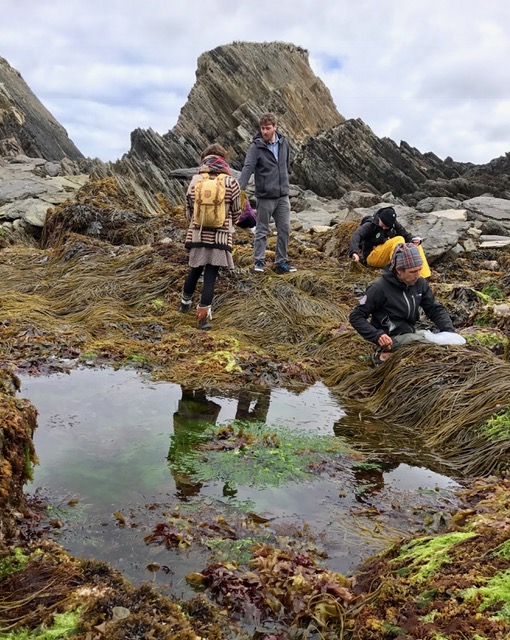| "...I have done my best to set down the character of the people about me so that some record of us might live after us, for the like of us will never be again." |
In brief, these are not the Basket Islands, as I first thought... The Blasket Islands are a group of islands off the west coast of Ireland, the largest of which is the Great Blasket Island. This island was the home of an Irish-speaking community living in stone cabins on the sheltered northeast side of the island. In 1953 the island was abandoned. A number of books that recorded much of the island's traditions and way of life were written by these islanders *. One was "The Islander" by Thomas O'Crohan.
Thomas O'Crohan wrote about his life on Ireland's Great Blasket Island from the 1860s to the 1920's.Life on the island was hard. There was no priest, pub, or doctor. Clearly this centuries-old lifestyle of the islanders was doomed to pass away even as O'Crohan published his book in 1929.
Truly "... the like of us will never be again."
O'Crohan wrote with great verbal richness
My friend Janet and I were doing an Irish course in Ballyferriter (near Dingle) and our class discussed the Blasket Islands (in Irish, of course!). Irish was the language spoken on the Great Blasket Island. So we'll do a little Irish...
The Blasket Islands
Cá Bhfuil na Blascaodaí?
An bhfuil an Blascaod Mhór an-mhor?
Where are the Blasket Islands? They are off the west coast of Ireland, near Dún Chaoin (Dunquin) and the Dingle peninsula. The origin of the name Blasket is uncertain; possibly Viking - brascar, a sharp reef. Although first thought to be inhabited over a thousand years ago by a monastic settlement the earliest written record from 1597 of the Blasket Islands was recently discovered in an archive in Spain.
Is Blascaod Mór very large? The Great Blasket Island is the largest of the Blasket Islands but it not large, about three miles long.
Your visit to the Great Blasket Island can be for a couple of hours, or an overnight stay.
Jumping off spots. Boats run from Ceann Trá (Ventry), Dún Chaoin (Dunquin) and Dingle. Eco tours incorporating a visit to the Great Blasket Island and a trip around the rest of the Blasket islands is also available.
Jumping off spots. Boats run from Ceann Trá (Ventry), Dún Chaoin (Dunquin) and Dingle. Eco tours incorporating a visit to the Great Blasket Island and a trip around the rest of the Blasket islands is also available.
Leaving from Ceann Trá (Ventry)
We went with Marine Tours and would highly recommend them. (https://www.marinetours.ie). Our departure was from Ceann Trá (Ventry). The road to the wharf in Ceann Trá can be hard to find; it's a small lane off the main road. Just ask anyone or anywhere in town for directions.
Awaiting the boat in Ceann Trá - the rain had just stopped and did not resume until we returned from the tour!
An Falcóg translates to The Auk. Auks are short-winnged diving seabirds found in northern oceans, typically with a black head and black and white underparts. Guillemots and puffins are auks, plus others.
Auks painted by Archibald Thorburn
The boat (above) is a naomhóg [nay-vōg]. Yawls were preferred by Blasket islanders, but when boats were taxed, they changed to currachs/coracles which were not taxed. The resultant cross between the yawl and the currach makes the Naomhóg. The boat is light and designed to be beached in surf.
In Memoriam Along the coasts of Ireland and any coastal area, I suppose, there are stories of loss. I was told by a 7th generation Irishman on Inis Mór, one of the Aran Island, that he had lost a brother to the sea AND that every family on the island had known such loss...
A cloud of sadness hangs over West Kerry this week; they lost a remarkable man, a poet, writer, boatbuilder and a warm engaging storyteller. Danny Sheehy died off the coast of Portugal when his naomhóg overturned.
He was making a documentary in which he travelled to Spain by naomhóg before taking part in the Camino de Santiago I was a beneficiary of his wonderful stories and knowledge on several of my visits to Ireland. https://www.rte.ie/news/2017/0610/881677-spain/
The Irish have a beautiful way of talking about death. Tá sé imithe ar an tslí na fírinne. He has gone away on the way of truth.
In Memoriam Along the coasts of Ireland and any coastal area, I suppose, there are stories of loss. I was told by a 7th generation Irishman on Inis Mór, one of the Aran Island, that he had lost a brother to the sea AND that every family on the island had known such loss...
A cloud of sadness hangs over West Kerry this week; they lost a remarkable man, a poet, writer, boatbuilder and a warm engaging storyteller. Danny Sheehy died off the coast of Portugal when his naomhóg overturned.
He was making a documentary in which he travelled to Spain by naomhóg before taking part in the Camino de Santiago I was a beneficiary of his wonderful stories and knowledge on several of my visits to Ireland. https://www.rte.ie/news/2017/0610/881677-spain/
The Irish have a beautiful way of talking about death. Tá sé imithe ar an tslí na fírinne. He has gone away on the way of truth.
Leaving from Dún Chaoin (Dunquin).
This architectural wonder of a pedestrian lane leads down to boat ramp at Dún Chaoin. Note the five naomhóga stored next to the shed.
Dún Chaoin harbor
Oops! You must walk down to the harbor. Don't try driving down the pedesterian lane!
Bird and whale watching is great on these tours. The Blaskets are a Special Protection Area under the E.U. Birds Directive. For the storm petrel, the site is the most important in the world. Species typical of western islands include Oystercatcher, Rock Dove, Wheatear, Raven and, possibly, Twite. We were treated to a viewing of minke whales on our trip.
Our boat captains
Mick Sheeran (R-above) and his co-captain are experienced and capable sailors. Between them they must have 90+ years on the sea!
There is a tricky landing at the Great Blasket Island's little boat ramp that may make getting off/on a challenge
An bhfuil éinne ag mareachtaint ar an oileán fé láthair.
Is there anyone living on the island presently? There are a few people who live on the island during the summer working in the small café that serves drinks, coffee/tea and scones! Yummy! Daily there are many tourists on the island during the summer. You can stay overnight in a small self-catering hostel now. Also inhabiting the island are sheep, donkeys, rabbits....
In the background, the dark "line" between beach and ocean is a group of gray seals. They are probably molting as they spend a greater portion of time on land during molting.
There are trails all over the island.
For hikes and sights see: http://www.gokerry.ie/locations/na-blascaoda-blasket-islands/
From: My Kerry Ancestors.com
An mó duine a bhí ar an oileán tráth dá raibh?
Cen sórt bia a bhí le n-ithe?
How many people were on the island? There were 153 people on the island in 1841. The population declined to 27 in 1951. Oddly enough, during the Irish potato famine the population of the island did not decrease in the same proportion as the mainland. The island was largely self sufficient and didn't depend on potatoes.
What sort of food was there to eat? Seal meat, fish, birds' eggs, sheep, garden vegetables, seaweed, potatoes, etc
The Great Blasket was inhabited until 1953 when a decline in their population and turf, their only source of fuel, became scarce. The islanders asked to be relocated and aided by Government grants the last inhabitants were settled on the mainland. Most went to the parish of Dún Chaoin where they and their descendants can still look across the hauntingly beautiful Blasket Sound toward the island that held so many memories for them.
Some came to the U.S. particularly Springfield MA. Among the students in the Ballyferriter Irish class was Gerald C. who hails from Springfield. Gerald is liofa (proficient) in Irish and put us all to shame! His friend Mike Carney, who lived in Sprinfield was from the Blaskets.
Some came to the U.S. particularly Springfield MA. Among the students in the Ballyferriter Irish class was Gerald C. who hails from Springfield. Gerald is liofa (proficient) in Irish and put us all to shame! His friend Mike Carney, who lived in Sprinfield was from the Blaskets.
An bhfuil tithe ar an oileán fós?
Are there houses on the island still? Yes, most abandoned and in ruins. A few have been repaired. The last houses were built on the island in the 1940's
Sea pinks
Seals frolicking in the sea
For those that spotted the blue sea in a few pictures and the grey sea in most photos... Pics from 2016 & 2017 respectively.
*It was the home of three noted Irish writers: Tomás Ó Criomhthain, Peig Sayers and Muiris Ó Súilleabháin. Their books can be found throughout Ireland and on-line.





















































